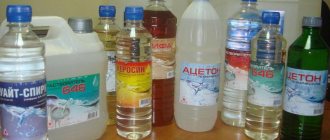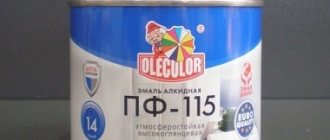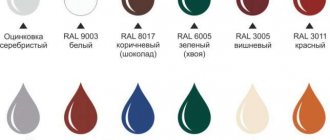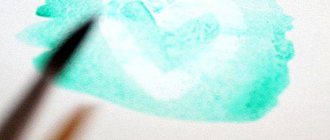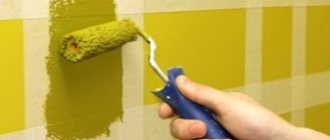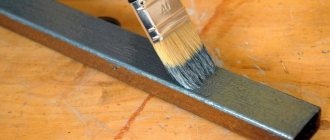Are acrylic and alkyd paints compatible?
Enamel paint, or enamel, can be oil-based, alkyd, epoxy, polyurethane, etc. The composition of paintwork materials determines the properties of acrylic and alkyd enamels. It depends on the properties whether acrylic paint can be applied to enamel.
Find out if acrylic and alkyd paints are compatible.
Review of manufacturers
Today, the building materials market offers polyurethane paints from many manufacturers. The price per jar depends on the popularity of the brand, volume and shape of the package. The most popular are German, Turkish, and Greek paints. The CIS countries produce products that are not inferior in their characteristics, and their prices are an order of magnitude lower.
Foreign trains are sold at a higher price due to the high cost of transportation and brand recognition. Domestic products undergo serious quality control and have the necessary certificates and licenses. Each type of coating has its own shelf life. It does not matter what type of coating is needed - varnish, enamel or paint. You can safely buy products from Russian brands.
Separately, it is necessary to note polyurethane paints from China. The Celestial Empire represents the largest market for paints and varnishes of any type and purpose.
Thus, paints based on complex polymers not only have a protective function and impart properties such as antistatic, impact resistance, and anti-slip properties to the surface, but also improve the appearance of the coating.
Properties of acrylic enamels
Acrylic enamels consist of a binder base, solvent, filler, and additional substances. The composition may contain pigment.
The binding base is a polymer material. Acrylic resin is used for its production. The quality of the resin affects the characteristics of the finishing material.
The solvent used in acrylic paints is water or special thinners that speed up drying.
Various substances are used as fillers: ground talc, sand, dusted quartz, asbestos dust, fiber. The type of filler affects the properties of the material. Pigments add color and increase service life.
- do not change under the influence of ultraviolet radiation, temperature and humidity;
- dry quickly;
- safe, no pungent odor;
- have a long service life;
- resistant to aggressive chemicals.
Thanks to this, the paint protects objects from corrosion. Does not fade in the sun, is not subject to mechanical damage, and does not peel off under the influence of temperatures. Used for work inside buildings and outdoors. Before applying paint, the surface is cleaned, degreased and covered with primer.
Main Differences
Alkyd enamel is sold ready-made; nefras and white spirit can be used as solvents. The word alkyd itself in translation combines alcohol and acid, which explains the production of the substance from alkyd resin by heat treatment of vegetable oils in combination with polyhydric alcohols. The alcohol component can be glycerin or pentaerythritol. Acrylic paint is based on polyacrylic polymers, they are obtained by hydrolysis of lactic acid.
The differences between these finishing materials are as follows:
- The alkyd composition dries in 1-2 days, acrylic enamel sets in a few hours, but hardens completely in up to 30 days. During this period, mechanical impact on the surface should not be allowed.
- When applied to metal, acrylic lasts up to 10 years or more, when processing wood - up to 8 years. Alkyd compositions last no more than 2-3 years; they are destroyed under the influence of sunlight and oxygen. It is recommended to update surfaces every 1-2 years to maintain an attractive appearance.
- The cost of acrylic compositions is high. Alkyd mixture can be purchased at a more affordable price.
- Another difference between acrylic paint and alkyd paint is the former’s significant resistance to mechanical stress. Due to the fact that the layer takes much longer to form, the acrylic coating is not afraid of deformation and damage. It is also resistant to ultraviolet radiation, the layer does not deform, the paint remains bright and retains its color.
- Acrylic compositions are less bright, more matte, and have muted colors. Among alkyd compositions there is a huge number of different colors, shades, halftones, the colors are bright and saturated.
Scope of application, features
The solution to the question of which is better, alkyd or acrylic enamel, depends on the area of application of the compositions. Acrylic paints are more often used for facade and construction and finishing works; they are resistant to atmospheric influences, can withstand high temperatures, and do not fade in the sun. They have good hiding power and relatively low consumption.
They provide natural ventilation of the material, are suitable as a coating for light wood, and for painting metal heating radiators. Provides corrosion protection with appropriate additives.
High adhesion allows for long-lasting results; on wooden surfaces the composition lasts up to 8 years, on metal or plastered surfaces – up to 10 years. Working with this species requires the use of solvents.
For your information! The acrylic composition is synthetic, the alkyd paint is natural!
Alkyd paint is a universal finishing material and can be applied to metal, stone or wood surfaces. The film it forms is less elastic.
Of the minuses: this type of paint is not resistant to ultraviolet radiation, and after a few years it loses its rich color and turns yellow. When working, the paint emits a specific odor; after painting the surfaces, the room should be thoroughly ventilated.
Properties of alkyd enamels
Alkyd enamels contain alkyd varnish, solvents and various fillers. May include a coloring pigment.
Pentaphthalic varnish, which is a thick resin, is most often used in production.
To regulate the viscosity of paints and varnishes, the solvent white spirit, which is obtained from oil refining, is often used.
Granite or marble chips and fine sand are used as filler. Additional agents - antiseptics, antifungal elements. Alkyd enamel can be matte, glossy or semi-matte. Applied to objects, it protects surfaces from snow, rain, moisture, scratches, chips and other mechanical influences. Alkyds dry quickly. Can be used outdoors, indoors.
- do not change under the influence of atmospheric phenomena;
- dry quickly;
- can be used for painting any surfaces: metal, wood, plaster, etc.;
- applied evenly to a cleaned and primed surface;
- the color scheme has different shades;
- fade in the sun;
- may crack when exposed to temperatures;
- They have a pungent odor and require ventilating the room after use.
Disadvantages of alkyd primer.
- long drying period;
— if the alkyd primer has not dried completely, some paints may curl upon contact with it;
- only the upper part of the surface is processed. That is, the alkyd primer does not penetrate deep into the material and cannot be used as a fixative for crumbling and loose materials. For them it is necessary to use acrylic primers;
— a construction bandage made of synthetic material that is not completely glued to the surface cannot be wetted with an alkyd primer. Because the bandage will bubble and stretch;
— despite the fact that white spirit is not a highly toxic substance, it is still quite harmful.
Is it possible to apply acrylic paint to alkyd paint and vice versa?
To work on one surface, it is better to use paintwork materials that have the same base.
When repainting a surface, you need to take into account the compatibility of the bases and know the rules for applying a new layer to the old coating:
- Do not mix acrylic paint with alkyd paint. Such enamels are produced only in industrial conditions using special technologies. They are used in mechanical engineering and are expensive.
- It is not recommended to coat acrylic enamel with alkyd paint. The materials contain solvents that are incompatible with each other. Alkyd paints applied to an acrylic base will peel off.
- It is allowed to use acrylic paint over alkyd enamel. In this case, acrylic is applied to an alkyd coating from which the volatile elements have evaporated. The surface is cleaned, degreased and an acrylic primer is applied. This field is covered with a new layer. The service life of alkyd-based paint is 2 times less. This option is suitable for wooden surfaces, but is not suitable for painting metal objects.
- You can paint with acrylic paint over a similar material after the first layer has dried - from 30 minutes to 2 hours, or after complete polymerization - after 24 hours.
- The same paint can be applied to an alkyd base no later than 1.5 hours after painting the first layer or after the base has completely dried.
To obtain the desired result when painting, it is better to remove the old paint.
To do this you can:
- clean off the old coating with a sharp object or a power tool with the required attachment;
- soften the paint by heating it with a hair dryer;
- remove the old layer using chemical remover solutions.
Advantages of alkyd primer.
— high soil strength;
- resistant to abrasion after drying;
— reliably covers resinous knots. They are not visible even after several years;
— any paints (acrylic, alkyd, enamel, latex and nitro paint), glue (wallpaper, universal, PVA) and putties (acrylate and acrylic) lie smoothly on it;
— in addition to metal surfaces, alkyd primer is suitable for priming wood, plastic, plaster, laminated surfaces, chipboard, fiberboard, concrete, as well as surfaces previously painted with any paint;
- Can be used at sub-zero temperatures;
- low-toxic chemical composition. You can work without using special protective equipment; it is enough that the room is simply well ventilated;
— you can dilute the alkyd primer or clean the surface from it using white spirit. Inexpensive and accessible chemical.
Table of correct combinations
When repainting old coatings, you need to consider the combination of different painting materials with each other. When applying a new base to an old one, instead of the expected decorative and protective effect, you can ruin the product. With the right combination of types of paintwork materials, the paint will lay down in an even layer and will adhere tightly.
The table below contains information about the compatibility of certain paints and varnishes with each other:
| Type of paints and varnishes | Type of old coating | ||||||||||||
| AK | AC | AU | VL | GF | ML | MCH | PF | UR | FL | HV | EP | ||
| Alkyd acrylic paints AC | AC | + | + | — | + | — | — | + | + | — | + | + | + |
| Alkyd-urethane AC | AU | — | — | + | + | + | — | — | — | — | + | — | + |
| Glypthal GF | GF | + | — | — | + | + | — | — | + | — | + | — | + |
| Organosilicon CO | KO | + | — | — | — | — | — | — | — | — | — | — | — |
| Oil MA | MA | — | — | — | + | + | — | — | + | — | + | — | — |
| Melamine ML | ML | + | — | — | + | + | + | + | + | — | + | — | + |
| Urea (carbamide) MPs | MCH | + | — | — | + | + | + | + | + | — | + | — | + |
| Nitrocellulose NC | NC | + | — | — | + | + | — | — | — | — | + | — | — |
| Perchlorovinyl CV | HV | + | — | — | + | + | + | + | + | — | + | + | + |
| Polyurethane UR | UR | + | — | — | + | + | — | — | + | + | + | — | — |
| Pentaphthalic PF | PF | + | — | — | + | + | — | — | + | — | + | — | + |
| Epoxyester EP | EP | + | — | — | + | + | — | — | + | — | + | — | + |
| Polyacrylate AK | AK | + | — | — | + | + | — | + | — | — | + | — | + |
How to choose
The choice of paint begins with determining how it will be used: interior, decorative or applied. There are two types of paint composition: organic and synthetic. Each of them is based on artificial resins. Dyes are used to create coloring pigment. Artificial pigments appear in bright and rich colors, and the natural base appears in pastel colors.
As already mentioned, acrylic is a universal type of paint and varnish materials. It can be used in any room. Acrylic dye is not afraid of moisture. You don't have to be a master to carefully cover any surface with it. First of all, buyers choose a material by color, then turn to information about the purpose. It can be found on the packaging. There is permanent paint, for ceilings, for facades or for interior work.
So, there are usually several types of acrylic paints:
- Wear-resistant
paint is recommended for rooms with high levels of humidity. - Deep matte and matte
paints are suitable for walls and ceilings in dry rooms. They hide small and insignificant irregularities, are easy to apply and have breathable properties. Before this, you need to remove the whitewash from the ceiling. - Glossy
paint does not hide unevenness and visually enhances texture.
The color range of paints is wide.
It is possible to make the shade yourself; for this, colors are used. They interfere with the white color and create the desired shade. Kohler is a concentrated paint. It can be thick or liquid.
It is enough to follow the following points to properly mix the paint with the color:
- carefully read the instructions and color chart;
- use paint and colors from the same manufacturer;
- mix them in a separate container;
- You only need to mix the amount that needs to be used for painting at the moment.
Exterior paint
used to cover house facades and other outdoor items.
There are two types of paint for facade work: water-based and based on organic compounds. The second is especially good for working at low temperatures in winter. It lays flat and dries quickly at sub-zero temperatures. Acrylic paint is highly wear-resistant, highly protective and durable, making it suitable for concrete products. The paint protects concrete from the influence of weather conditions and mechanical stress.
Acrylic-based coating is also chosen for wooden products. It has the following properties:
- resistance to changes in temperature and moisture;
- wear resistance prevents cracks from forming on the wooden surface;
- retains color for ten years;
- it is characterized by vapor permeability;
- dries quickly;
- easy to use;
- no need to scrape off the old layer to apply a new coat of paint.
Artists and designers use acrylic to paint furniture, create patterns on glass, designs on fabric and for painting.
There is acrylic for children's creativity - this paint is brighter and easier to wash off. It is non-toxic and is stored in plastic jars. There are also paints that have special properties, such as glow in the dark, fluorescent and pearlescent.
Paint for decorative works
Available in jars and tubes. Both forms of storage are convenient to use. Paint in tubes can be purchased individually. It is worth noting that jars and tubes of paint come in different sizes. Acrylic fabric paints are distinguished by their elastic properties. When heated with an iron, they acquire a plastic structure and penetrate into the fabric. After dyeing, it is recommended to wash items by hand.
Acrylic nail
It is also stored in jars and tubes. The material in the jars is necessary to create a pattern with a brush or using other tools. If necessary, the paint can be diluted with water. Thanks to the narrow spout at the end of the tube, the paints are ready for use immediately. Tubes can also be purchased individually.
Combination of enamel and acrylic paint
Painted surfaces often have to be renewed, regardless of whether the finishing work was carried out efficiently and correctly. But first of all, you need to decide what paint can be used for external and internal finishing work.
First, you need to remove the old layer of material. This is done by several methods:
- Clean off the previous coating with sharp tools or a drill with a specific attachment;
- Heated with a hairdryer for construction, this softens the previous paint, and the paint coating is easily removed;
- Wash off with various special solvents.
The difference between enamel and acrylic paint in composition and technical characteristics
The most common types of materials used in repairs are acrylic and alkyd, which are more advanced types of oil-based enamels.
Although they are often confused, they differ radically in composition:
- Alkyd. Compared to enamels, these paints dry faster and form a protective film on the surface. It contains polyhydric alcohols, for example, glycerin and orthophthalic acid;
- Acrylic. They are produced on the basis of plexiglass, with the addition of components that improve the properties of oil paints.
According to technical characteristics, the following differences can be distinguished between enamels and acrylic paints:
- Acrylic coating has a significantly longer service life compared to oil-based or water-based enamels. Exposure to oxygen and ultraviolet rays significantly affect the surface of the paintwork;
- When applied, acrylic is more resistant to sunlight and is not as susceptible to fading and yellowing;
- Alkyd film, due to the rapid formation of a protective film, dries in a short time, within a couple of days, while the acrylic surface will reach its ideal strength only after a month;
- But the long drying process makes the acrylic coating much stronger than alkyd, protecting the surface from scratches and deformations;
- Alkyd paints have a brighter and more varied range of colors.
Main components
All painting materials can be divided according to their constituent solvents and astringent properties:
- There are main types of substances that determine viscosity and main qualitative features: latex, epoxy, acrylic, oil;
- Both thinners are used, which only reduce the viscosity, and solvents, in addition making the coating less fluid;
- What additives are used for greater efficiency;
- Paints that have the properties of getting rid of mold and preventing corrosion.
Let's look at the main types of painting substances and their differences.
Oil and enamel compositions
They are used when applied to metal, wood and plaster.
Important! After use they have no toxic emissions and are resistant to light and liquids.
- Oily substances are made from drying oil. Gasoline, white spirit or turpentine are added for dilution. The cost is low, which attracts users, but they take a long time to dry and after some time acquire a yellowish tint;
They are used when applied to metal, wood and plaster.
Important! After use they have no toxic emissions and are resistant to light and liquids.
- A special varnish is added to paint coatings that contain enamel, which makes the surfaces smoother and more attractive.
Enamels are also impervious to light and moisture, protect the repair site from corrosion, and are used on metal, concrete, wood and plaster.
Emulsion and dispersion materials
These coatings are diluted with water, but the unique properties do not allow substances to dissolve in it, forming a viscous emulsion.
Such materials adhere well to various substrates, dry in a short period of time, do not have an unpleasant odor, and burn poorly.
Most people assume that these materials have the same properties, but this is not the case.
- Emulsions are susceptible to washing off, so dispersion paints and varnishes are used in damp rooms;
- Water emulsions have a large selection of colors and shades;
- Compositions based on aqueous dispersion cannot be used at low subzero temperatures.
Attention! In terms of their properties, the leading positions among these types of paints are occupied by materials based on acrylic surfaces, resins and polymers, which add strength and elasticity.
Types of enamel coatings
There are many varieties of enamel compositions. Only the most common ones are listed below:
- Nitrocellulose. They contain cellulose nitrate, pigmenting substances, additives, fillers and solvent. Most often used for painting metal, concrete and wood. Packaged in cans and aerosol cans. A characteristic feature is a pungent acetone smell. Without preparation in accordance with technological instructions, combination with other paints is unacceptable.
- Organosilicon. Such compositions can be applied to materials and surfaces of all types. The characteristic qualities of silicone enamel coatings include moisture resistance, increased strength and wear resistance. This type of paint and varnish materials can only be combined with dried acrylic coating.
- Pentaphthalic and glyphthalic. They belong to a subtype of oil paints and are made from combined and synthetic drying oils after modification with alkyds. This type of paintwork material is compatible with polyurethane-alkyd, acrylic and epoxy compounds.
- Acrylic. They are a latex-based aqueous dispersion. Acrylic enamels can only be combined with paints and varnishes that are water-based. However, it is also possible to combine with other types of paints, subject to appropriate preparation.
- Urethane and alkyd-urethane. They are characterized by very high strength and wear resistance. Such compositions can be applied to surfaces painted with oil, epoxy or pentaphthalic paints.
About paint compatibility
Many people wonder whether it is possible to apply acrylic paint on top of oil paint, and vice versa, enamel on an acrylic base?
Attention! To begin with, it is recommended to coat the surface with epoxy putty.
- It is advisable to apply acrylic paint only to a similar coating;
- You cannot use alkyd and epoxy resins to paint past glossy and varnished bases;
- Any coating can be applied to dispersion and emulsion materials.
Is it possible to paint with acrylic paint over oil paint?
The choice of one or another type of paint must be approached as responsibly as possible, since the durability of the coating, its aesthetic characteristics, as well as the ability to provide conditions for a person’s comfortable stay in the room depend on the solution to this issue. When choosing a paint composition, you should also consider whether this will be the first painting or whether it will be a repair of a previously painted surface. Many property owners who have decided to make cosmetic repairs to the premises of their apartments or houses are interested in the answer to the question: “Is it possible to paint surfaces that were previously painted with oil paint with acrylic paint?” It should be noted right away that you should not try to find the answer to the question posed among sellers of building materials stores or specialists who have worked their entire career with only one of the specified compositions. Most of these people may not even know from what initial components these paintwork materials are made, so they cannot draw a conclusion about compatibility. Having received an answer from them, the home master runs the risk of hearing a purely individual opinion and, as a result, making the wrong choice.
Painting features
The quality and durability of a painted surface depends not only on the choice of coating, but also on the quality of its application. Therefore, below we will consider how to properly paint wood with waterproof paintwork.
So, the instructions look like this:
- You need to start work by preparing the surface - the wood must be cleaned of the old coating, putty and sanded if necessary.
- Then the paint is prepared - shaken thoroughly; if the composition is tinted, then the required amount of color is added to it to obtain one or another shade.
- Next, apply the composition with your own hands onto the wooden surface in a thin, even layer. To do this, you can use a sprayer, paint roller or brush.
- After the first layer has hardened, the coating is applied again. In most cases, two coats are sufficient to achieve an even color and a smooth surface.
This completes the painting process.
Characteristics of oil and acrylic paint
Before answering the question posed in the title of the article, it is necessary to talk in detail about the characteristics of each of these paints and varnishes.
Oil paint
Even in the very last years of the previous century, oil paints occupied a leading position in the coatings market. These coloring compositions were in demand everywhere; they were applied to any internal or external surfaces of premises for any economic purpose. The position of oil paints has somewhat weakened after the appearance of nitro enamels on store shelves. And after widespread production of water-dispersion coloring compositions was established, oil paints became less in demand compared to other paints and varnishes.
Is it possible to mix different formulations?
When preparing for painting work, it is not always possible to stock up on the required amount of paint and varnish material. Sometimes it is tempting to use different types of paints made on the same base to mix and apply together.
The water base of both paints will promote normal miscibility, but the quality of the polymer coating cannot be unequivocally guaranteed. Ready-made acrylic-based latex paints are manufactured in a factory, and their compositions are selected in the laboratory. If there is no strict need to use an artificial mixture of acrylic and latex water-based paints, it is better to avoid such a dubious experiment.
Acrylate latex paints are more expensive than conventional acrylic mixtures, but significantly expand the range of work performed. The strength of the resulting coating is higher and sufficient for intensive cleaning or washing. You should not use latex compounds everywhere - in some cases you can get by with standard acrylic paint for all types of surfaces.
When undertaking renovations in their own home, the owners try to think through every detail of the upcoming work and select the appropriate materials for it. Wallpaper, tiles, and stone can be used to decorate interior surfaces, but wall paint is most often used recently. Latex products, thanks to a number of positive qualities, stand out noticeably against the background of other coloring compositions, winning more and more sympathy from the consumer. For this reason, in today’s article we will pay attention specifically to latex paints, analyzing their types, properties and application technology.
How to apply acrylic paint over oil paint?
And now, knowing the main advantages and disadvantages of each paint, taking into account the peculiarities of their chemical composition, we will answer the main question: “Is it possible to apply acrylic paint to oil paint without completely removing its layer?”
If the layer of oil paint adheres firmly to the surface, does not peel off, and has no cracks or chips, acrylic paint called “Master-121” can be applied on top. This coloring agent is a universal composition, which is characterized by the highest degree of adhesion to even the most even and smooth surfaces.
Using “Master-121”, you can be completely confident that acrylic paint will reliably adhere to a layer of oil paint. This option is the simplest solution.
Acrylic paint adheres very well to surfaces previously painted with oil paint. However, so that acrylic paint does not begin to peel off from the oil base after some time, the surface to be painted must be treated most carefully. During surface preparation, it is necessary to perform the following types of work:
- Thoroughly sand the surface on which the acrylic paint will be applied using fine-grit sandpaper.
- Next, dust, dirt, and remaining abrasive material should be removed from the surface, and then degreased. As a degreaser, you can use a solution of soap in warm water.
- Wait until the degreasing solution dries completely.
- Paint the surface to be treated with several layers of acrylic paint.
Having completed the entire range of preparatory work described above, some home craftsmen still doubt the reliability of such a connection. In order for acrylic paint to adhere well to a surface previously painted with oil paint, the coloring agent must be diluted with water in a 1:1 ratio.
Tips and tricks
In order to create a beautiful design with acrylic paints, you need to follow some guidelines. So, during the process of work, many people have a question about how to dissolve such compositions, because they are quite thick and dense. The most common solvent is water. It can be used if only because it is part of almost all acrylic paints.
But after you dilute the paint with water and mix it, a protective film will form on all tools. That is why, immediately after mixing and applying this paint to the surface, it is necessary to thoroughly rinse and clean all fixtures and tools. This must be done within an hour after completion of work.
You can also dilute paints using compounds specially designed for this. They are sold ready-made. In addition, with their help you can transform an acrylic-based composition if you do not want to buy another one or accidentally made a mistake in your choice. The thinner can make the paint glossy or, conversely, matte.
When diluting paint with water, it is necessary to maintain the correct ratio. The ideal option is dilution in proportions of one to one. Then the paint will cover walls and other surfaces without leaving gaps. It is better to use thinned paint first as a base and then apply it as a second coat.
If you want to apply a very thin layer of acrylic paint or make its shade less bright, then you need to dilute it with water in a ratio of one to two. This composition will saturate any surface well and lay down in a thin layer.
Some people also have problems with acrylic paints drying out. But to solve this problem, they only resort to diluting it with water and stirring it. It is not right. Experts recommend first turning dried mixtures into powder, grinding them using special equipment, and then pouring boiling water over the resulting powder.
After this, you need to wait until the water has cooled completely. It must be carefully drained so that the paint elements remain in the container again. Then you need to repeat this procedure. On the second lap, do not drain all the water completely. It is enough to leave about half of this composition so that there is enough water to dilute the paint to the desired consistency.
Although the composition of this paint will be similar to what it was before drying, if you carry out this procedure, its quality characteristics will become worse. With its help, it is better to paint only utility buildings and some discreet interior elements. It is not recommended to paint over an accent wall with this coating.
Experts give many recommendations regarding the process of applying paint and technology for working with acrylic compositions. Before painting walls or other surfaces with acrylic compounds, they must first be prepared. To do this, remove excess dirt and dust, clean the walls and ceilings from greasy stains and streaks.
Before using such compositions, it is necessary to level all surfaces, otherwise the paint may highlight all the imperfections. Before applying paint, it is necessary to remove all old coatings, including paintwork. For this it is better to use a high-quality spatula. Even small particles of paint remaining after cleaning can ruin the new coating.
It is better to treat cleaned surfaces with a primer before applying the composition. In this way, you can protect the walls and ceiling from bacteria and fungus and reduce the consumption of acrylic composition when painting. Acrylic paint should not be applied if the surfaces have cracks or uneven surfaces. All of them must be covered with putty.
Acrylic paints must be applied to the surface of walls and ceilings in a certain sequence. First you need to paint all the corner areas and draw clear lines along the entire perimeter of the walls and other surfaces using a roller. Then you need to paint the central part with it. You should work in the corners with a brush to paint them better.
In order for the white coating on the walls to look smooth and of high quality, you must follow one of the rules. So, the last decorative layer must be applied horizontally with a roller towards the window. When applying paint to walls, two layers are considered the minimum. But, as a rule, it is applied in three layers. This way you can achieve the brightest and most saturated color, and also cover up all the gaps.
The highest quality painting can be achieved using a spray gun. This mechanical method of painting requires certain skills.
Is it possible to paint with acrylic paint over oil paint?
Acrylic and oil paints are used to paint both the exterior and interior of a building. Situations often arise when you need to paint with acrylic a surface on which there is a layer of old oil paint. Is it possible to combine these two completely different colors? To answer this question, it is necessary to understand in more detail the properties of both types of paint and varnish compositions.
Features of oil and acrylic paints
Oil base
Just some 20-30 years ago, oil-based enamels completely dominated the market. Such solutions were used both for painting facades and indoors. The first serious competitor to oil was nitro-enamel, and the dominance of oil-based compositions was finally shaken after the start of mass production of water-based paints, primarily acrylics.
Oil-based paints and varnishes are produced on the basis of natural drying oil or its synthetic analogue mixed with mineral pigments. To obtain paint, its components are ground until a homogeneous mixture is formed.
Today, oil-based paints and varnishes are used infrequently, but sometimes there is still a need for them, for the following reasons:
- Affordability allows you to paint large areas with oil paints at the lowest cost. Low cost is the main factor in the popularity of the oil: as long as prices are low, the demand for such solutions will exist.
- Resistant to the negative effects of moisture. The oil protects wooden, concrete and metal surfaces from moisture penetration into their structure.
- Often oil paint is chosen because the surface has already been painted with drying oil. Not all home craftsmen are aware of the possibility of applying an acrylic composition to such a surface, and therefore choose the simplest option - buy an oil solution.
- The application of this paint and varnish material does not require any special knowledge or skills: you just need to dilute the composition with a solvent and stir.
Oil solutions also have serious disadvantages that limit their use:
- Not too many colors to choose from. Most often, stores have up to 10-12 shades in their assortment.
- Low coating strength. For this reason, the painted surface needs regular updating (at least annually), which will require additional financial investments and labor costs.
- Toxicity of solutions. This category of paints is characterized by a specific and very persistent odor. If painting is carried out inside a building, you will need to organize high-quality ventilation. At the same time, while the paint is drying, you should avoid staying indoors to avoid poisoning from toxic fumes.
- Long drying times. It will take at least 24-48 hours for the treated coating to dry completely. And this is under ideal environmental conditions (appropriate levels of humidity and temperature, as well as the presence of ventilation).
Acrylic base
Compositions based on acrylates are characterized by the following advantages:
- Compared to oil paints, acrylic paints are much more environmentally friendly because they do not contain organic solvents. Since acrylic solutions are based on water, such paints do not have a strong odor.
- Huge selection of colors and subtle shades. It is possible to order the desired color directly in the store: the composition will be made in a special machine right in front of the buyer.
- Resistant to moisture, ultraviolet radiation, temperature changes, vapor permeability. As a result, acrylic can be used both indoors and for painting facades.
- High surface strength. The coating becomes harder as it dries (water evaporates).
- Quick drying time - just a few hours. Moreover, some compositions can dry in just an hour.
- Long service life of the coating. Compared to oil paint, acrylic paint is at least twice as durable.
The only significant drawback of acrylic is its cost. However, quality is worth paying for.
Alkyd or oil
Alkyd paints are the most widely used among solvent-based paints today. Although the production and use of well-known oil paints still continues.
Characteristics of oil paints
The binder of oil paint is oil, which dries through the process of oxidation. It could be flax ma
layer, linseed oil drying oil, oil-saturated alkyd resin or a mixture of various oils. Flaxseed oil is a low-molecular binder that perfectly penetrates wood, forming a dense waterproof film. Linseed oil paints have a high solids content. This is due to the fact that linseed oil does not require solvents as a binder and therefore contains a minimal amount of volatile compounds.
The advantage of oil materials is a high degree of filling, as well as low consumption. They are excellent as primers, for example for planking. They are characterized by rather slow drying.
Characteristics of alkyd paints
The binder for alkyd materials is alkyd resin. Alkyd resins are mainly made by cooking vegetable oils - linseed, tallow, soybean, etc. - together with alcoholic and organic acids or acid anhydrides. Like oils, alkyd resins dry out as a result of oxidation. The higher the fat content (percentage of oil) of the alkyd resin, the more flexible the paintwork. The drying speed of alkyd resins is regulated by special additives—driers.
By selecting the type of oil, you can influence the drying time, color and gloss of the alkyd varnish. As a rule, paints and varnishes based on alkyd varnish are easy to apply and have higher weather resistance compared to oil paints. Alkyd materials dry faster, do not shrink when dry, do not turn yellow and, unlike oil paints, practically do not chalk. Alkyd paints traditionally protect various types of surfaces both inside and outside the building (doors, window frames, furniture, radiators, etc.) from wear and corrosion. Alkyd paints can withstand wet cleaning with water and conventional detergents. They are used to paint walls and ceilings in kitchens and bathrooms. If you want to get a glossy finish, these paints are also chosen.
Table 1. Comparison of alkyd and oil paints
Drying time, days
2-24 (from setting to full strength)
Question: “What is the difference between paint and enamel?” - sounds very often, but even those who are associated with paint and varnish materials by profession cannot always give a clear answer. There is a common belief that enamel is the same as enamel paint. Many people believe that the whole difference between enamel and paint is that the first material is shiny, and the second is matte. Of course, this conclusion is incorrect. Despite the apparent similarity of definitions, there are more significant differences between definitions such as “paint,” “enamel,” and “enamel paint” than the presence or absence of gloss.


